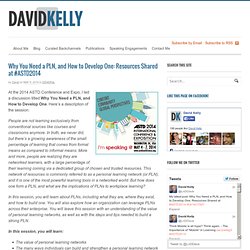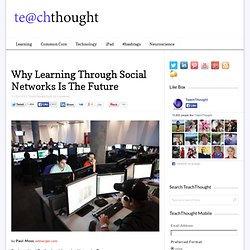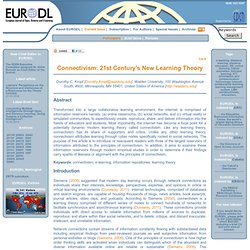

Building Your Personal Learning Network. How to Create a Robust and Meaningful Personal Learning Network [PLN] This post describes how educators can develop a personal learning network that supports meaningful and relevant learning. The MOOC, Education Technology & Media, etmooc, is used here as a working example of how to develop a PLN. “My Personal Learning Network is the key to keeping me up-to-date with all the changes that are happening in education and how technology can best support and engage today’s students.”
Brian Metcalfe: teacher, blogger at lifelonglearners.com. Stephen Downes, Researcher at National research council canada. 10 Simple Ways To Build Your Personal Learning Network. 8 Ideas, 10 Guides, And 17 Tools For A Better Professional Learning Network. Personal learning networks are a great way for educators to get connected with learning opportunities, access professional development resources, and to build camaraderie with other education professionals.

Although PLNs have been around for years, in recent years social media has made it possible for these networks to grow exponentially. Now, it’s possible to expand and connect your network around the world anytime, anywhere. But how exactly do you go about doing that? Why (And How) Teachers Should Start Using iTunes U. Courtesy: maconstate.edu With so many schools adopting the use of iPads I find it strange that we aren’t hearing more about the incredible opportunities available in iTunes U.

Well I suppose it isn’t that strange given that schools in the early stages of transitioning to an iPad platform are extremely busy and learning one more thing can seem overwhelming. Trust me, I understand that, but I believe if you were to learn one more thing it should be about the power of iTunes U. The possibilities of this incredible tool are endless. I’d like to provide you with just a few examples of the many uses of iTunes U in the hopes that more schools will join this incredible network of learning resources.
The first and likely most exciting benefit of iTunes U is the multitude of incredible classroom resources at your disposal. When I think of the potential of iTunes U, the first thing that comes to my mind are the incredible communities that developed around SMART board users. Solar System Ecosystems. Building Adult Capabilities to Improve Child Outcomes: A Theory of Change. Preparing your workforce for tomorrow. I created a performance improvement toolbox when I started this blog in 2004, and have kept adding to it over the years.

I often look at workplace performance first from the perspective of whether the situation we are trying to address is complicated or complex. Training works well for complicated problems, when you have clear and measurable objectives. Training looks backwards, at what worked in the past (good & best practices), and creates a controlled environment to develop knowledge and skills. Training can be good to develop ways to reduce errors, which is only one part of improving organizational performance. Complex problems often require insight, beyond what training can prepare you for.
Many vendors and training practitioners try to sell one-size-fits-all solutions, but there are no cookie-cutter solutions in the complex domain. Why You Need a PLN, and How to Develop One: Resources Shared at #ASTD2014. At the 2014 ASTD Conference and Expo, I led a discussion titled Why You Need a PLN, and How to Develop One.

Here’s a description of the session: People are not learning exclusively from conventional sources like courses and classrooms anymore. Sloan-C eLearning Landscape. At a recent conference, David Wiley, open education pioneer said that MOOCs (massive open online courses) were essentially 1999 online learning with the password protection taken away.

He’s certainly not alone in his dislike of all things MOOC – and no wonder. In the last three years the theory-work of decades of educators has been ignored and co-opted. A few good self-branders have suddenly discovered people can learn online. Worse, these people are becoming the voices of online learning and are, in some cases, claiming to be the discoverers of educational approaches we’ve all been using since the dawn of the Internet.
Along with these activities, old school behaviorist approaches to learning have been married to MOOCs as if the only way to learn at-scale on the Internet is to standardize everything. Why You Need a PLN, and How to Develop One: Resources Shared at #LSCon. At the 2014 Learning Solutions Conference and Expo, I led a discussion titled Why You Need a PLN, and How to Develop One.

Here’s a description of the session: People are not learning exclusively from conventional sources like courses and classrooms anymore. Writing on the Wall. IN JULY 51BC the Roman statesman and orator Marcus Tullius Cicero arrived in Cilicia, in what is now south-east Turkey, to take up the post of proconsul, or regional governor.

Cicero had been deeply reluctant to leave the bustle of Rome, where he was a central figure in the plotting and counter-plotting of Roman politics, and he intended to return as soon as was decently possible. The burning question of the day was whether Julius Caesar, commander of Rome’s armies in the west, would make a grab for power by marching on the city. Cicero had spent his career trying to defend the political system of the Roman republic, with its careful division of powers and strict limits on the authority of any individual, from Caesar and others who wished to centralise power and seize it for themselves. But a new anti-corruption law required Cicero and other trustworthy elder statesmen to take up posts as provincial governors.
At the time there were no printing presses and no paper. Like this: Why Learning Through Social Networks Is The Future. By Paul Moss, edmerger.com Students Need Professional Learning Networks, Too Learning to create, manage and promote a professional learning network (PLN) will soon become, if it’s not already, one of the most necessary and sought after skills for a global citizen, and as such, must become a prominent feature of any school curriculum.

Few progressive educationalists would argue that a personal learning network (PLN) is not incredibly valuable and important. Passionate advocates including Murray, Whitby, and Sheninger lead with clarity in such discussions. The wealth of professional development that stems from such a network is quickly defining it as an essential tool for teachers, and will, I believe, replace organised costly professional development undertaken by organisations. However presently, few discussions and promotions of PLN’s venture further than lauding specific benefits for teachers. 1.
To curate or not to curate – that is actually not the question. 2. 3. Edutopia.org/blog/how-do-i-get-a-pln-tom-whitby. European Journal of Open, Distance and E-Learning. Dorothy C.

Why Communities of Practice die young. I have just been reading a very interesting article entitled The Rise and Fall of a Community of practice: A Descriptive Case Study, by Alton Chua.

I can't find an online version for you, I'm afraid, but the article describes the experience of developing a community of e-learning instructional designers at Holden College, and why the initiative, which seemed to enjoy a promising start, fizzled out completely in less than one and- a-half years. Unfortunately this seems to happen all too often. I have spoken with many companies, with experience of attempting to use Communities of Practice, only to see them fizzle out and die. The Holden College example shows typical reasons for failure, which can be summarised as follows. 1. 2. 3. 4. Sites don't create communities; communities create sites. The value proposition for a community of practice. The value proposition of a CoP is in increasing the effectiveness of its members.
A community does not hold a collective performance objective with the business but allows each member to deliver better against his or her own individual performance objectives, by giving them access to the knowledge base of the community. Specifically the community offers Help in solving problems Faster learning Access to experience and expertise Access to proven practices Membership of a CoP should pay its way. If you don't get benefit from being a member, then the CoP is not working. Many communities have voluntary membership on this basis, and it serves as a self-regulating mechanism. If the community adds value to the members, the old members stay, new members join, and membership grows. If the community does not add value to the members, then members leave and the community dies. It's as simple as that.